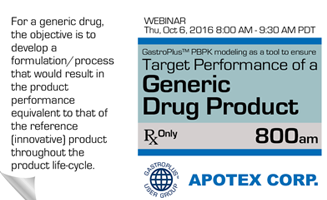For many orally administered basic drugs with pH-dependent solubility, concurrent administration with acid-reducing agents (ARAs) can significantly impair their absorption and exposure.

Folate-targeted amphiphilic cyclodextrin.siRNA nanoparticles for prostate cancer therapy exhibit PSMA mediated uptake, therapeutic gene silencing in vitro and prolonged circulation in vivo
In this study, a folate targeted cyclodextrin (CD) nanoparticle was prepared by co-formulating CD.siRNA complexes with DSPE-PEG5000-folate to target the prostate specific membrane antigen (PSMA).

Physiologically Based Absorption Modeling to Design Extended-Release Clinical Products for an Ester Prodrug
Absorption modeling has demonstrated its great value in modern drug product development due to its utility in understanding and predicting in vivo performance.

Modeling and Simulation Strategy to Support Eslicarbazepine Acetate (ESL) Development in Pediatric Patients in the Treatment of Partial-Onset Seizures
Eslicarbazepine acetate (ESL, Aptiom®) was FDA approved for adjunctive treatment of partial-onset seizures (POS) in adults aged 18 years and older, with subsequent approval as monotherapy.

Intracellular unbound drug concentrations: methodology and application for understanding cellular drug exposure
Most known drug targets and metabolizing enzymes are located inside cells.

hERG Datasheet
The hERG (human Ether-à-go-go Related Gene) encodes potassium channels that are responsible for the normal repolarization of the cardiac action potential.

Biodegradation Datasheet
Understanding biodegradation of chemicals in the environment is becoming increasingly important.

Interactive Code for Guiding Dose Selection
Assuming a linear one-compartment model for the pharmacokinetics (PK) with and without dose-dependent saturable bioavailability, and a direct inhibitory Emax model for bio-marker effect (PD), develop an...

Pharmacokinetic-Pharmacodynamic Modeling and Simulation to Predict Efficacy Outcomes With Eslicarbazepine Acetate 800 mg Once Daily as Monotherapy for Partial-Onset Seizures
Eslicarbazepine acetate (ESL) is a once-daily (QD) oral antiepileptic drug (AED), approved as adjunctive treatment for partial-onset seizures (POS) in the USA, Europe, and Canada, and as monotherapy for POS in the USA.

Providing Insight into Novel Dosing Protocols Using a Quantitative Systems Pharmacology (QSP) Model of Drug-Induced Liver Injury
Elevations in serum alanine aminotransferase (ALT) were observed in phase I clinical studies for a novel inpatient anti-infective therapy (Compound X).

Mechanistic Modeling with Dilisym® Predicts Species Differences in CKA Via Multiple Hepatotoxicity Mechanisms
To predict species differences in CKA-mediated hepatotoxicity using DILIsym®, a mechanistic model of drug-induced liver injury (DILI)

Mechanistic Modeling of Drug-Induced Liver Injury Due to mtDNA Depletion in DILIsym®
To simulate drug-induced liver injury (DILI) due to mitochondrial DNA (mtDNA) depletion in DILIsym using Fialuridine (FIAU) as an exemplar compound.

High throughput virtual screening and in silico ADMET analysis for rapid and efficient identification of potential PAP248-286 aggregation inhibitors as anti-HIV agents
Human semen is principal vehicle for transmission of HIV-1 and other enveloped viruses.

Predicting Exposure After Oral Inhalation of the Selective Glucocorticoid Receptor Modulator, AZD5423, Based on Dose, Deposition Pattern, and Mechanistic Modeling of Pulmonary Disposition
Exposure following oral inhalation depends on the deposition pattern of the inhaled aerosol, the extent and rate of oral and pulmonary absorption, as well as systemic distribution and clearance.

Comprehensive QSRR modeling as a starting point in characterization and further development of anticancer drugs based on 17α-picolyl and 17(E)-picolinylidene androstane structures.
The selection of the most promising anticancer compounds from the pool of the huge number of synthesized molecules is a quite complex task.

Application of Physiologically Based Absorption Modeling to Characterize the Pharmacokinetic Profiles of Oral Extended Release Methylphenidate Products in Adults
A previously presented physiologically-based pharmacokinetic model for immediate release (IR) methylphenidate (MPH) was extended to characterize the pharmacokinetic behaviors of oral extended release (ER) MPH formulations in adults for the first time.

2016 White Paper on recent issues in bioanalysis: focus on biomarker assay validation (BAV) (Part 1 – small molecules, peptides and small molecule biomarkers by LCMS)
The 2016 10th Workshop on Recent Issues in Bioanalysis (10th WRIB) took place in Orlando, Florida with participation of close to 700 professionals from pharmaceutical/biopharmaceutical companies, biotechnology companies, contract research organizations, and regulatory agencies worldwide.

GastroPlus™ PBPK modeling as a tool to ensure target performance of a generic drug product
For a generic drug, the objective is to develop a formulation/process that would result in the product performance equivalent to that of the reference (innovative) product throughout the product life-cycle.
